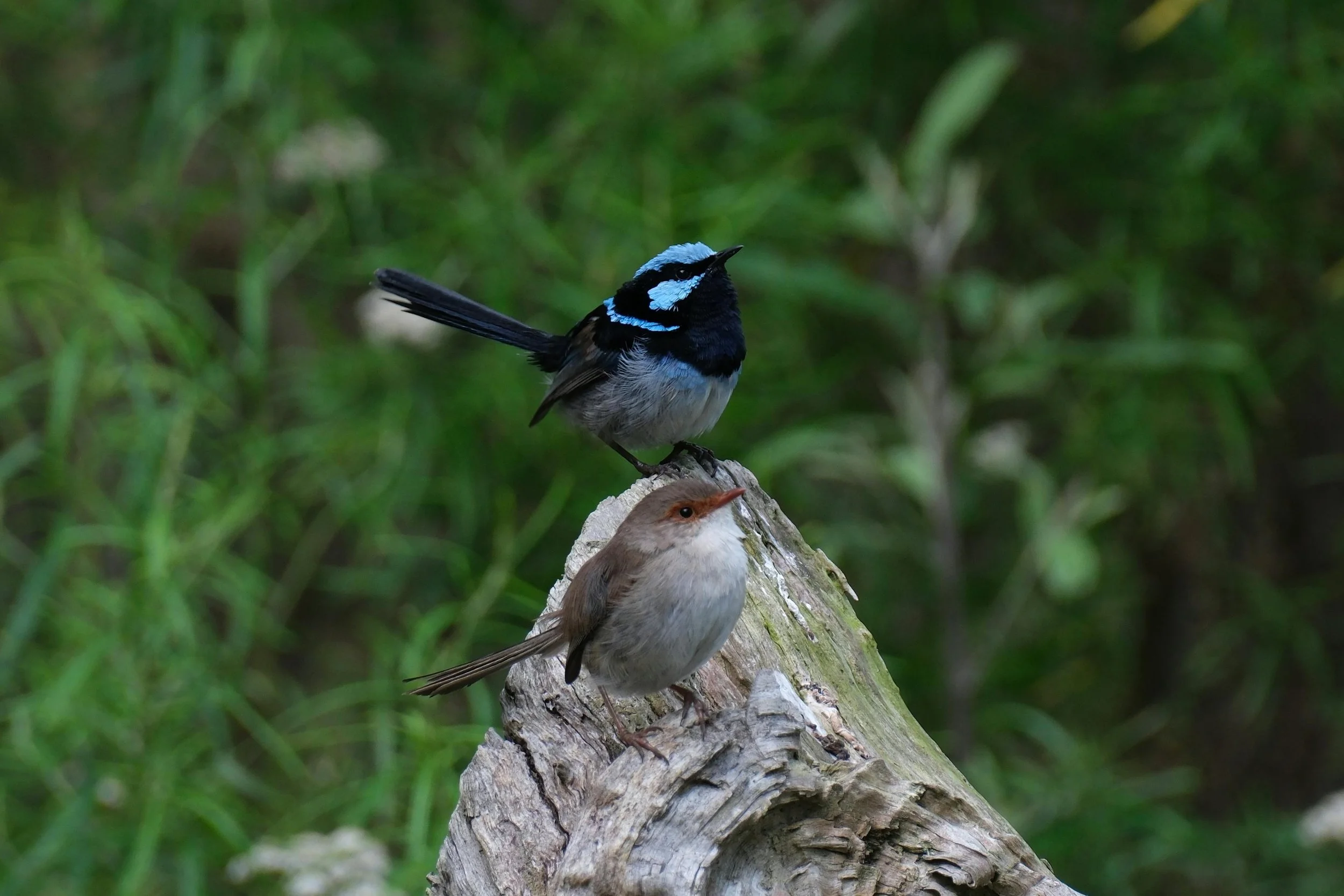Knocklofty Reserve - Fauna
A range of fauna have been identified, ranging through birds, frogs, reptiles, and marsupials. Over the past twenty-eight years, the presence of these fauna have been detected by:
bird watching and listening with experts from Birds of Australia;
scats, foot prints, diggings and trapping of marsupials with a wild life vet
listening to frog calls, catching tadpoles and frogs
looking for and identifying reptiles
Actions such as plantings, pond restorations, and weed removal have helped to improve the habitat of these fauna and encourage numbers and varieties to prosper on the reserve .
Superb fairy wren, image by Walter Coppola
-
Download this list in PDF format
Brown Quail
Found in areas of thick grassAustralian Wood Duck
"Grazes near water, often perches in trees"Pacific Black Duck
Very common and abundantWhite Bellied Sea Eagle
Occasionally seen overflying KnockloftyBrown Goshawk
Secretive but widespread and commonGrey (White) Goshawk
Regularly seen Knocklofty and W.HobartCollared sparrowhawk
Looks similar to Brown Goshawk but smallerWedge-tailed Eagle
Sometimes seen near Mt. WellingtonBrown Falcon
Common. Brown tear stripe is diagnosticAustralian Hobby
A rare visitor; very rapid in flightPeregrine Falcon
A powerful flyer12. Tasmanian Native Hen
Tasmanian endemicMasked Lapwing
Commonly called Spurwing PloverPacific Gull
Associated with McRobies Gully TipKelp Gull
Associated with McRobies Gully TipSilver Gull
Associated with McRobies Gully TipSpotted Turtle Dove
Call a mellowcoo or coocooCommonBronzewing
Call a very monotonous oom-oomBrush Bronzewing
Brown stripe through eye is diagnosticYellow tailed Black Cockatoo
Regularly seen in banksias near reservoirSulphur crested Cockatoo
Regularly seen on Knocklofty and in West HobartMusk Lorikeet
Noisy flocks frequently seen feeding on blossomGreen Rosella
Tasmanian endemicEastern Rosella
Red head and chestSwift Parrot
Migratory. Numbers declining (endangered) but regularly seen on Knocklofty in spring/summerPallid Cuckoo
Migratory - largest of Tasmania's cuckoosFan-tailed Cuckoo
Like all our cuckoos unable to make nestHorsfield's Bronze Cuckoo
Uncommon migrantShining Bronze Cuckoo
Metallic green bronze colouringSouthern Boobook
Often hear calling boo-bookor mo-pokeMasked Owl
Rarely seen feeding near street lightsTawny Frogmouth
Regularly seen feeding near street lightsWhite throated Needletail
Often seen in large flocks in late summer/early autumnLaughing Kookaburra
Introduced into TasmaniaSuperb Fairy Wren
Common on KnockloftySpotted Pardalote
Monotonous high pitched sleep baby callStriated Pardalote
Repetitive pick-id-up callBrown Thornbill
Very busy. Often seen in the canopyTasmanian Thornbill
More common in wetter sitesYellow-rumped Thornbill
Largest thornbill. Regularly seen in groups feeding on the groundYellow Wattlebird
Largest honeyeater. EndemicLittle Wattlebird
Heavily white streaked plumageNoisy Minor
"Often in noisy, aggressive flocks"Yellow-throated Honeyeater
Very common endemicStrong-billed Honeyeater
White eye stripe flocks. EndemicBlack headed Honeyeater
Often in noisy flocks. EndemicCrescent Honeyeater
Egypt callNew Holland Honeyeater
Streaked black & white plumage with yellow wing patchEastern Spinebill
Rufous colouringScarlet Robin
Most common robin on KnockloftyFlame Robin
Partly migratoryPink Robin
Prefers wet forestDusky Robin
Larger & more robust appearance compared to other robinsOlive Whistler
Low sweet whistle often with whip crack at the endGolden Whistler
Males have beautiful yellow plumageGrey Shrike Thrush
Beautiful joe whitty callSatin flycatcher
Common summer migrantGrey fantail
Sometimes known as Cranky FanBlack-faced Cuckoo Shrike
Common summer migrant. Shuffles wings on alightingDusky Woodswallow
Common summer migrant.Grey Butcherbird
Common residentAustralian Magpie
Black Currawond
Common endemicGrey Currawong
Common nomadic. Clinking callForest Raven
House Sparrow
Introduced in 19th CenturyBeautiful Firetail
Red rump is diagnosticGreenfinch
Looks like a canary. IntroducedGoldfinch
"Introduced in 1880's. Red, black, yellow and white markings"Welcome Swallow
Common summer migrant. Forked tailTree Martin
Common summer migrant. Square tailSilver Eye
White eye ringGround Thrush
Common resident. Prefers wet forestBlackbird
Introduced to Tasmania in 1930'sStarling
Introduced to Tasmania in 1860
-
Tasmanian mammals
Echidna
Eastern quoll
Eastern barred bandicoot
Southern brown bandicoot
Tasmanian pademelon
Bennett's wallaby
Bettong
Tasmanian bettong
Long-nosed potoroo
Common brush-tail possum
Ring-tail possum
Brushtail possum
Eastern pygmy possum (probable)
Swamp ratFeral (introduced) mammals
House mouse
Black rat
Rabbit
Hare -
Brown tree frog (common)
Tasmanian froglet possibly (2020) no longer present due to chytrid fungus
Eastern banjo frog (2016) no longer present due to chytrid fungus
Spotted marsh frog (common)
Southern toadlet - thought to be no longer present due to chytrid fungus, but a call was reported in November 2025
Common froglet (common)
-
Blue-tongue lizard
Copperhead
Tiger snake
White-lipped or whip snake (probable)
Mountain dragon
Numerous skink species in various habitats - grasslands, dry woodland and rocky dolerite areas

